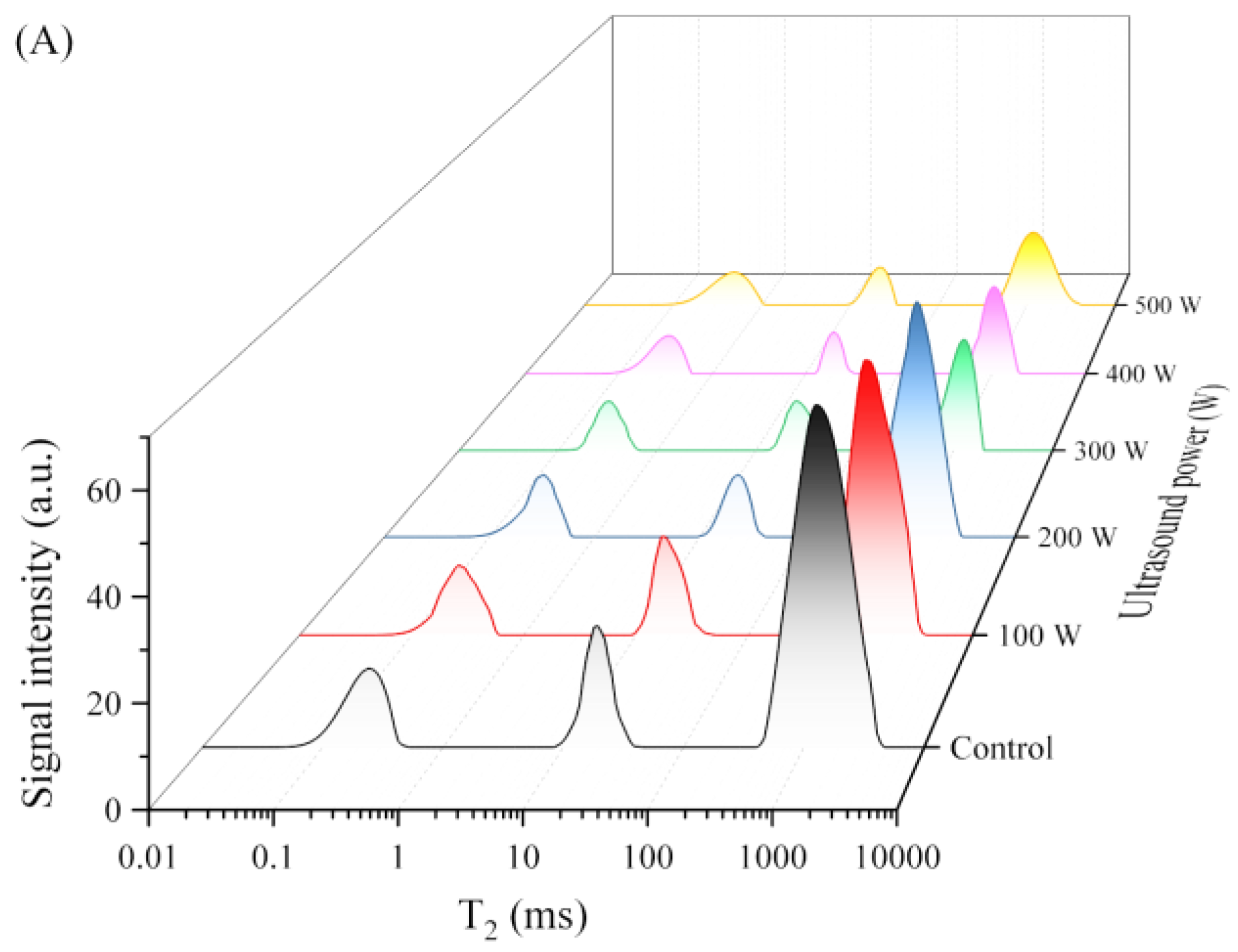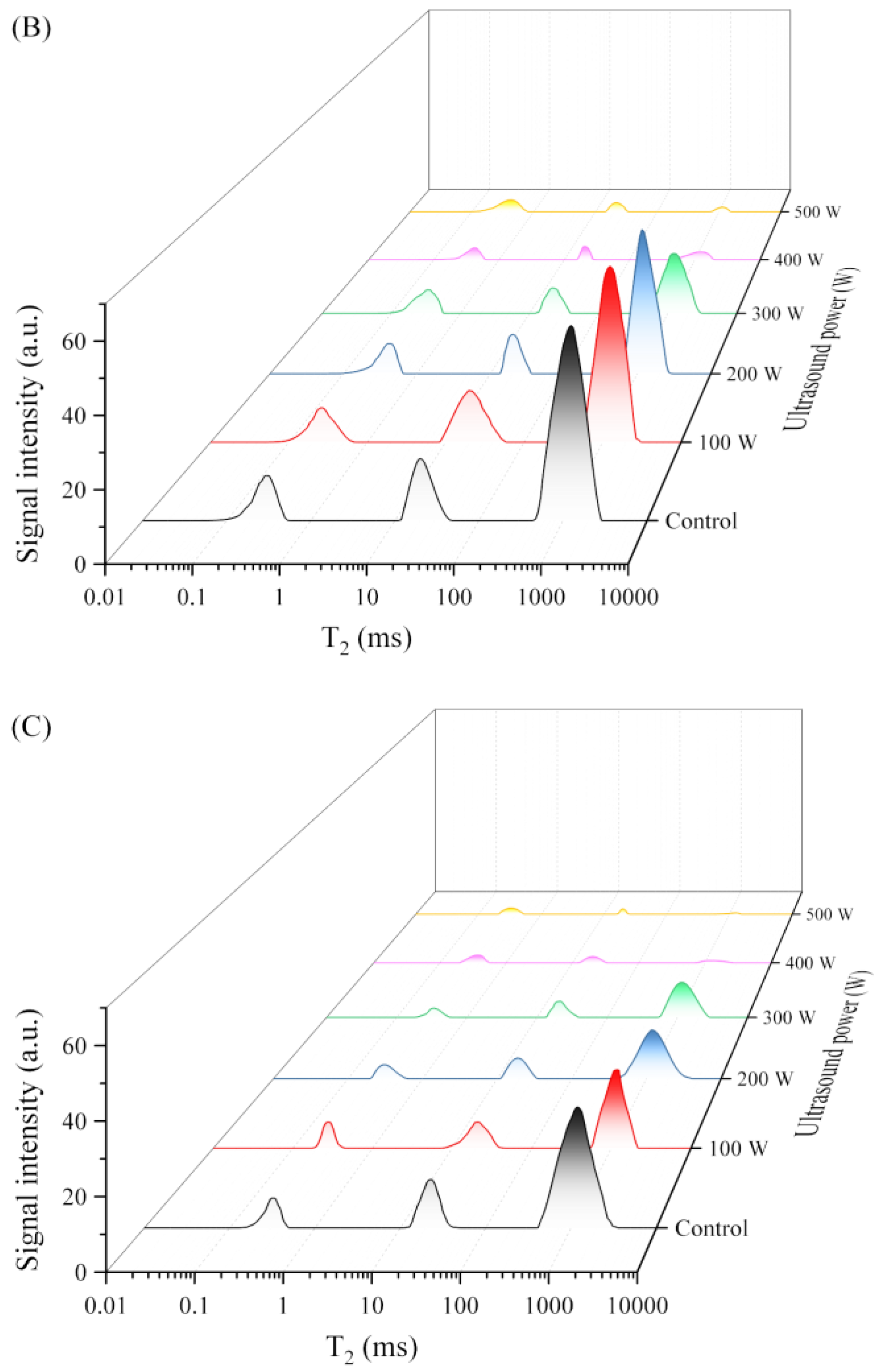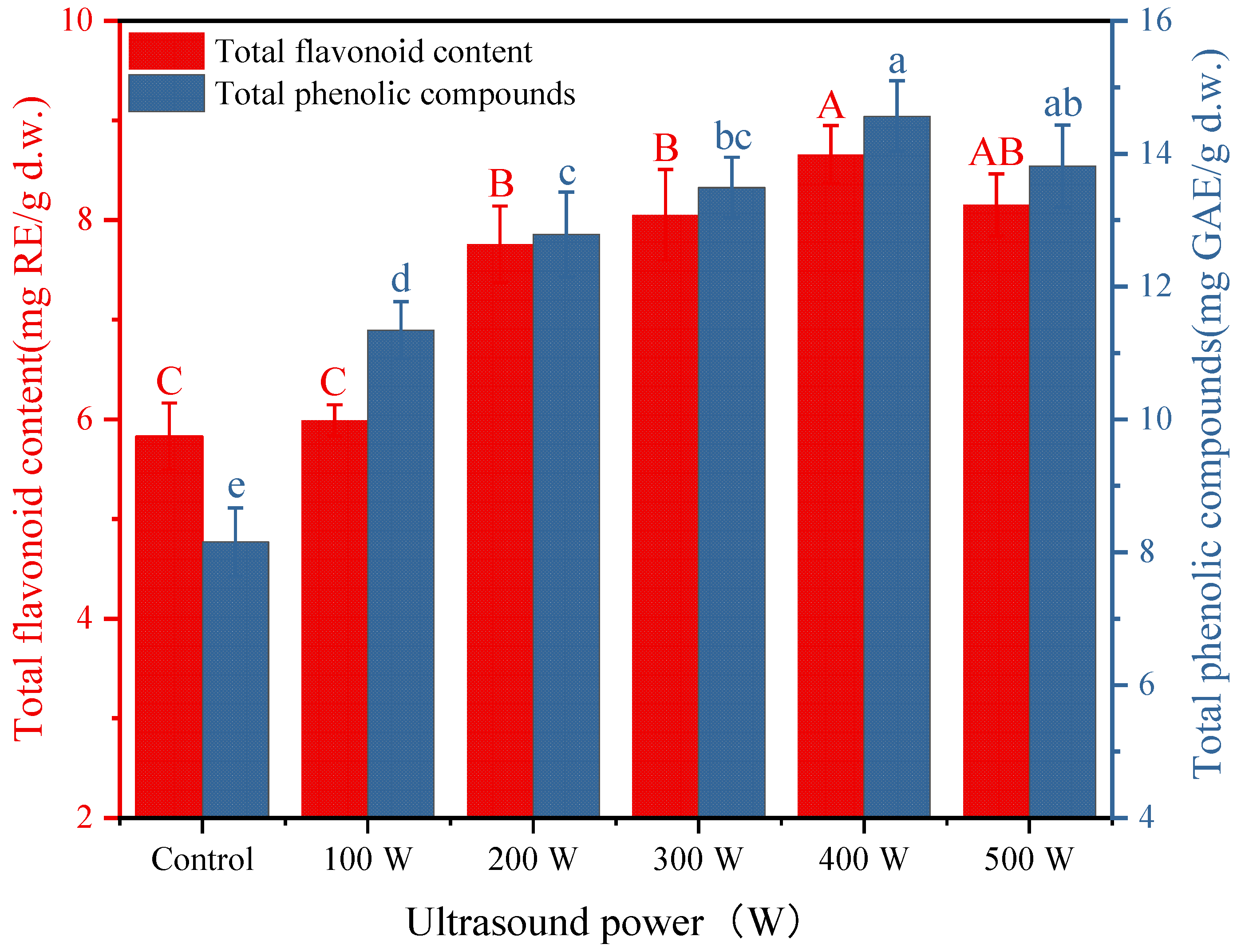Effect of Ultrasound Pretreatment on the Moisture Migration and Quality of Cantharellus cibarius Following Hot Air Drying
Abstract
:1. Introduction
2. Materials and Methods
2.1. Raw Materials
2.2. Ultrasound Pretreatment
2.3. Hot Air Drying
2.3.1. Measurement of Moisture Ratio
2.3.2. Measurement of Drying Rate
2.4. LF-NMR Measurement
2.5. MRI Measurement
2.6. Scanning Electron Microscopy (SEM)
2.7. Color Determination
2.8. Rehydration Ratio
2.9. Determination of Bioactive Substances and Antioxidant Activities
2.9.1. Antioxidant Activity (DPPH)
2.9.2. Total Phenolics Content (TPC)
2.9.3. Total Flavonoid Compounds
2.10. Statistical Analysis
3. Results and Discussion
3.1. Drying Characteristics of C. cibarius
3.2. LF-NMR Analysis of C. cibarius
3.3. MRI Analysis of Drying of C. cibarius
3.4. Effect of Different Ultrasonic Pretreatment Powers on Sample Microstructure
3.5. Effect of Different Ultrasonic Pretreatment Powers on the Color of Samples
3.6. Effect of Different Ultrasonic Pretreatment Powers on the Rehydration Ratio of the Samples
3.7. Effect of Different Ultrasonic Pretreatment Powers on Nutritional Quality
4. Conclusions
Author Contributions
Funding
Data Availability Statement
Conflicts of Interest
References
- Ozturk, B.; Havsut, E.; Yildiz, K. Delaying the postharvest quality modifications of Cantharellus cibarius mushroom by applying citric acid and modified atmosphere packaging. LWT-Food Sci. Technol. 2021, 138, 110639. [Google Scholar] [CrossRef]
- Sumic, Z.; Tepic, A.; Vidovic, S.; Vakula, A.; Vladic, J.; Pavlic, B. Process Optimization of Chanterelle (Cantharellus Cibarius) Mushrooms Vacuum Drying. J. Food Process. Preserv. 2017, 41, e12822. [Google Scholar] [CrossRef]
- Oliveira, F.; Sousa-Gallagher, M.J.; Mahajan, P.V.; Teixeira, J.A. Development of shelf-life kinetic model for modified atmosphere packaging of fresh sliced mushrooms. J. Food Eng. 2012, 111, 466–473. [Google Scholar] [CrossRef] [Green Version]
- Politowicz, J.; Lech, K.; Sanchez-Rodriguez, L.; Szumny, A.; Carbonell-Barrachina, A.A. Volatile composition and sensory profile of Cantharellus cibarius Fr. as affected by drying method. J. Sci. Food Agric. 2017, 97, 5223–5232. [Google Scholar] [CrossRef] [PubMed]
- Zhang, L.H.; Zhang, M.; Mujumdar, A.S. Development of flavor during drying and applications of edible mushrooms: A review. Dry. Technol. 2021, 39, 1685–1703. [Google Scholar] [CrossRef]
- Tian, Y.T.; Zhao, Y.T.; Huang, J.J.; Zeng, H.L.; Zheng, B.D. Effects of different drying methods on the product quality and volatile compounds of whole shiitake mushrooms. Food Chem. 2016, 197, 714–722. [Google Scholar] [CrossRef]
- Niu, D.; Wang, L.H.; Zeng, X.A.; Wen, Q.H.; Brennan, C.S.; Tang, Z.S.; Wang, M.S. Effect of ethanol adaption on the inactivation of Acetobacter sp. by pulsed electric fields. Innov. Food Sci. Emerg. 2019, 52, 25–33. [Google Scholar] [CrossRef]
- Deng, L.Z.; Mujumdar, A.S.; Zhang, Q.; Yang, X.H.; Wang, J.; Zheng, Z.A.; Gao, Z.J.; Xiao, H.W. Chemical and physical pretreatments of fruits and vegetables: Effects on drying characteristics and quality attributes—A comprehensive review. Crit. Rev. Food Sci. 2019, 59, 1408–1432. [Google Scholar] [CrossRef]
- Pei, F.; Xiao, K.P.; Chen, L.F.; Yang, W.J.; Zhao, L.Y.; Fang, Y.; Ma, N.; Mariga, A.M.; Hu, Q.H. Mass transfer characteristics during ultrasound-assisted osmotic dehydration of button mushroom (Agaricus bisporus). J. Food Sci. Technol. 2019, 56, 2213–2223. [Google Scholar] [CrossRef]
- Singla, M.; Sit, N. Application of ultrasound in combination with other technologies in food processing: A review. Ultrason. Sonochem. 2021, 73, 105506. [Google Scholar] [CrossRef]
- Zhu, Z.Z.; Zhao, Y.; Zhang, Y.X.; Wu, X.T.; Liu, J.; Shi, Q.L.; Fang, Z.X. Effects of ultrasound pretreatment on the drying kinetics, water status and distribution in scallop adductors during heat pump drying. J. Sci. Food Agric. 2021, 101, 6239–6247. [Google Scholar] [CrossRef] [PubMed]
- Rashid, M.T.; Jatoi, M.A.; Safdar, B.; Wali, A.; Aadil, R.M.; Sarpong, F.; Ma, H.L. Modeling the drying of ultrasound and glucose pretreated sweet potatoes: The impact on phytochemical and functional groups. Ultrason. Sonochem. 2020, 68, 105226. [Google Scholar] [CrossRef] [PubMed]
- Khan, M.K.I.; Ghauri, Y.M.; Alvi, T.; Amin, U.; Khan, M.I.; Nazir, A.; Saeed, F.; Aadil, R.M.; Nadeem, M.T.; Babu, I.; et al. Microwave assisted drying and extraction technique; kinetic modelling, energy consumption and influence on antioxidant compounds of fenugreek leaves. Food Sci. Technol. 2022, 42, 1–9. [Google Scholar] [CrossRef]
- Prithani, R.; Dash, K.K. Mass transfer modelling in ultrasound assisted osmotic dehydration of kiwi fruit. Innov. Food Sci. Emerg. 2020, 64, 102407. [Google Scholar] [CrossRef]
- Li, X.; Li, J.; Wang, R.; Rahaman, A.; Zeng, X.A.; Brennan, C.S. Combined effects of pulsed electric field and ultrasound pretreatments on mass transfer and quality of mushrooms. LWT-Food Sci. Technol. 2021, 150, 112008. [Google Scholar] [CrossRef]
- Wali, A.; Ma, H.L.; Aadil, R.M.; Zhou, C.S.; Rashid, M.T.; Liu, X. Effects of multifrequency ultrasound pretreatment on the enzymolysis, ACE inhibitory activity, and the structure characterization of rapeseed protein. J. Food Process. Preserv. 2017, 41, e13413. [Google Scholar] [CrossRef]
- Cakmak, R.S.; Tekeoglu, O.; Bozkir, H.; Ergun, A.R.; Baysal, T. Effects of electrical and sonication pretreatments on the drying rate and quality of mushrooms. LWT-Food Sci. Technol. 2016, 69, 197–202. [Google Scholar] [CrossRef]
- Zhang, B.; Li, M.; Qiao, Y.T.; Gao, P.; Li, L.Y.; Zheng, Z.J. Potential use of low-field nuclear magnetic resonance to determine the drying characteristics and quality of Arctium lappa L. in hot-blast air. LWT-Food Sci. Technol. 2020, 132, 109829. [Google Scholar] [CrossRef]
- Su, D.B.; Sun, W.H.; Li, B.Z.; Yang, Y.; Wang, Y.; Lv, W.Q.; Li, D.; Wang, L.J. Influence of ultrasonic pretreatments on microwave hot-air flow rolling drying mechanism, thermal characteristics and rehydration dynamics of Pleurotus eryngii. J. Sci. Food Agric. 2022, 102, 2100–2109. [Google Scholar] [CrossRef]
- Li, B.R.; Lin, J.Y.; Zheng, Z.A.; Duan, H.; Li, D.; Wu, M. Effects of different drying methods on drying kinetics and physicochemical properties of Chrysanthemum morifolium Ramat. Int. J. Agric. Biol. Eng. 2019, 12, 187–193. [Google Scholar] [CrossRef] [Green Version]
- Mirzaei-Baktash, H.; Hamdami, N.; Torabi, P.; Fallah-Joshaqani, S.; Dalvi-Isfahan, M. Impact of different pretreatments on drying kinetics and quality of button mushroom slices dried by hot-air or electrohydrodynamic drying. LWT-Food Sci. Technol. 2022, 155, 112894. [Google Scholar] [CrossRef]
- Cheng, S.S.; Li, R.R.; Yang, H.M.; Wang, S.Q.; Tan, M.Q. Water status and distribution in shiitake mushroom and the effects of drying on water dynamics assessed by LF-NMR and MRI. Dry. Technol. 2020, 38, 1001–1010. [Google Scholar] [CrossRef]
- Yamchi, A.A.; Yeganeh, R.; Kouchakzadeh, A. Effect of ultrasonic pretreatment on drying kinetics and physio-mechanical characteristics of peach slices. J. Food Process. Eng. 2022, 45, 14053. [Google Scholar] [CrossRef]
- Zhao, Y.Y.; Yi, J.Y.; Bi, J.F.; Chen, Q.Q.; Zhou, M.; Zhang, B. Improving of texture and rehydration properties by ultrasound pretreatment for infrared-dried shiitake mushroom slices. Dry. Technol. 2019, 37, 352–362. [Google Scholar] [CrossRef]
- Wang, K.J.; Guo, J.T.; Cheng, J.X.; Zhao, X.H.; Ma, B.H.; Yang, X.B.; Shao, H.J. Ultrasound-assisted extraction of polysaccharide from spent Lentinus edodes substrate: Process optimization, precipitation, structural characterization and antioxidant activity. Int. J. Biol. Macromol. 2021, 191, 1038–1045. [Google Scholar] [CrossRef]
- Bao, T.; Li, Y.T.; Xie, J.H.; Sun, C.D.; Li, X.; Pu, Y.F.; Chen, W. Systematic evaluation of bioactive components and antioxidant capacity of some new and common bayberry cultivars using an in vitro gastrointestinal digestion method. Food Res. Int. 2018, 103, 326–334. [Google Scholar] [CrossRef]
- Konieczynski, P.; Lysiuk, R.; Wesolowski, M. Total flavonoid and ionic elements contents in 32 medicinal plants collected from natural habitats in Northern Ukraine. J. Herb. Med. 2021, 29, 100492. [Google Scholar] [CrossRef]
- Fijalkowska, A.; Nowacka, M.; Wiktor, A.; Sledz, M.; Witrowa-Rajchert, D. Ultrasound as a Pretreatment Method to Improve Drying Kinetics and Sensory Properties of Dried Apple. J. Food Process. Eng. 2016, 39, 256–265. [Google Scholar] [CrossRef]
- Li, L.L.; Zhang, M.; Wang, W.Q. Ultrasound-assisted osmotic dehydration pretreatment before pulsed fluidized bed microwave freeze-drying (PFBMFD) of Chinese yam. Food Biosci. 2020, 35, 100548. [Google Scholar] [CrossRef]
- Ni, J.B.; Ding, C.J.; Zhang, Y.M.; Song, Z.Q.; Xu, W.Q. Influence of ultrasonic pretreatment on electrohydrodynamic drying process of goji berry. J. Food Process. Preserv. 2020, 44, e14600. [Google Scholar] [CrossRef]
- Wang, J.; Xiao, H.W.; Ye, J.H.; Wang, J.; Raghavan, V. Ultrasound Pretreatment to Enhance Drying Kinetics of Kiwifruit (Actinidia deliciosa) Slices: Pros and Cons. Food Bioprocess. Technol. 2019, 12, 865–876. [Google Scholar] [CrossRef]
- Zeng, S.Y.; Wang, B.; Lv, W.Q.; Wang, L.J.; Liao, X.J. Dynamic analysis of moisture, dielectric property and microstructure of ginger slices during microwave hot-air flow rolling drying. Food Control 2022, 134, 108717. [Google Scholar] [CrossRef]
- Ozel, B.; Dag, D.; Kilercioglu, M.; Sumnu, S.G.; Oztop, M.H. NMR relaxometry as a tool to understand the effect of microwave heating on starch-water interactions and gelatinization behavior. LWT-Food Sci. Technol. 2017, 83, 10–17. [Google Scholar] [CrossRef]
- Zhao, Y.T.; Wang, W.W.; Zheng, B.D.; Miao, S.; Tian, Y.T. Mathematical modeling and influence of ultrasonic pretreatment on microwave vacuum drying kinetics of lotus (Nelumbo nucifera Gaertn.) seeds. Dry. Technol. 2017, 35, 553–563. [Google Scholar] [CrossRef]
- Wu, X.F.; Zhang, M.; Ye, Y.F.; Yu, D.X. Influence of ultrasonic pretreatments on drying kinetics and quality attributes of sweet potato slices in infrared freeze drying (IRFD). LWT-Food Sci. Technol. 2020, 131, 109801. [Google Scholar] [CrossRef]
- Wu, X.F.; Zhang, M.; Mujumdar, A.S.; Yang, C.H. Effect of ultrasound-assisted osmotic dehydration pretreatment on the infrared drying of Pakchoi Stems. Dry. Technol. 2020, 38, 2015–2026. [Google Scholar] [CrossRef]
- Zhu, D.S.; Liang, J.Y.; Liu, H.; Cao, X.H.; Ge, Y.H.; Li, J.R. Sweet cherry softening accompanied with moisture migration and loss during low-temperature storage. J. Sci. Food Agric. 2018, 98, 3651–3658. [Google Scholar] [CrossRef]
- Tan, M.Q.; Lin, Z.Y.; Zu, Y.X.; Zhu, B.W.; Cheng, S.S. Effect of multiple freeze-thaw cycles on the quality of instant sea cucumber: Emphatically on water status of by LF-NMR and MRI. Food Res. Int. 2018, 109, 65–71. [Google Scholar] [CrossRef]
- Jiang, N.; Liu, C.Q.; Li, D.J.; Zhang, J.; Zhang, Z.Y.; Huang, J.P.; Yu, Z.F. Effect of Thermosonic Pretreatment and Microwave Vacuum Drying on the Water State and Glass Transition Temperature in Agaricus bisporus Slices. Food Bioprocess Technol. 2018, 11, 172–184. [Google Scholar] [CrossRef]
- Zhang, T.; Wang, J.; Feng, J.Q.; Liu, Y.Q.; Suo, R.; Jin, J.Y.; Wang, W.X. Ultrasonic pretreatment improves the gelation properties of low-salt Penaeus vannamei (Litopenaeus vannamei) surimi. Ultrason. Sonochem 2022, 86, 106031. [Google Scholar] [CrossRef]
- Nowacka, M.; Wiktor, A.; Sledz, M.; Jurek, N.; Witrowa-Rajchert, D. Drying of ultrasound pretreated apple and its selected physical properties. J. Food Eng. 2012, 113, 427–433. [Google Scholar] [CrossRef]
- Pandiselvam, R.; Aydar, A.Y.; Kutlu, N.; Aslam, R.; Sahni, P.; Mitharwal, S.; Gavahian, M.; Kumar, M.; Raposo, A.; Yoo, S.; et al. Individual and interactive effect of ultrasound pre-treatment on drying kinetics and biochemical qualities of food: A critical review. Ultrason. Sonochem. 2023, 92, 1–20. [Google Scholar] [CrossRef] [PubMed]
- Rahaman, A.; Siddeeg, A.; Manzoor, M.F.; Zeng, X.A.; Ali, S.; Baloch, Z.; Li, J.; Wen, Q.H. Impact of pulsed electric field treatment on drying kinetics, mass transfer, colour parameters and microstructure of plum. J. Food Sci. Technol. 2019, 56, 2670–2678. [Google Scholar] [CrossRef] [PubMed]
- Mothibe, K.J.; Zhang, M.; Mujumdar, A.S.; Wang, Y.C.; Cheng, X.F. Effects of Ultrasound and Microwave Pretreatments of Apple Before Spouted Bed Drying on Rate of Dehydration and Physical Properties. Dry. Technol. 2014, 32, 1848–1856. [Google Scholar] [CrossRef]
- Shi, D.F.; Yin, C.M.; Feng, X.; Zhou, R.R.; Fan, X.Z.; Qiao, Y.; Yao, F.; Huang, W.; Liu, Y.; Gao, H.; et al. Effect of Ultrasound and Cellulase Pre-treatment on the Water Distribution, Physical Properties, and Nutritional Components of Lentinula edodes Chips. Food Bioprocess Technol. 2020, 13, 625–636. [Google Scholar] [CrossRef]
- Gamboa-Santos, J.; Montilla, A.; Soria, A.C.; Carcel, J.A.; Garcia-Perez, J.V.; Villamiel, M. Impact of power ultrasound on chemical and physicochemical quality indicators of strawberries dried by convection. Food Chem. 2014, 161, 40–46. [Google Scholar] [CrossRef] [PubMed]
- Jarahizadeh, H.; Dinani, S.T. Influence of applied time and power of ultrasonic pretreatment on convective drying of potato slices. Food Sci. Biotechnol. 2019, 28, 365–376. [Google Scholar] [CrossRef]
- Nowacka, M.; Wiktor, A.; Anuszewska, A.; Dadan, M.; Rybak, K.; Witrowa-Rajchert, D. The application of unconventional technologies as pulsed electric field, ultrasound and microwave-vacuum drying in the production of dried cranberry snacks. Ultrason. Sonochem. 2019, 56, 1–13. [Google Scholar] [CrossRef]
- Kalaras, M.D.; Richie, J.P.; Calcagnotto, A.; Beelman, R.B. Mushrooms: A rich source of the antioxidants ergothioneine and glutathione. Food Chem. 2017, 233, 429–433. [Google Scholar] [CrossRef]






| Ultrasound Power | Pileus | Stipe | ||||||
|---|---|---|---|---|---|---|---|---|
| L* | a* | b* | ΔE | L* | a* | b* | ΔE | |
| Fresh | 77.62 ± 0.76 a | 6.23 ± 0.43 e | 73.61 ± 0.42 a b | —— | 86.58 ± 0.40 a | 0.13 ± 0.03 b | 10.51 ± 0.72 d | —— |
| Control | 66.83 ± 1.18 d | 17.64 ± 0.91 a | 66.18 ± 3.34 d | 17.55 ± 2.03 a | 71.40 ± 0.43 d | 6.64 ± 0.55 a | 30.75 ± 0.51 c | 26.14 ± 0.31 c,d |
| 100 W | 71.38 ± 0.35 c | 7.99 ± 0.64d e | 71.84 ± 0.65 a,b,c | 6.82 ± 0.59 c | 71.44 ± 0.49 d | 6.80 ± 0.11 a | 31.85 ± 0.99 c | 27.08 ± 0.61 c |
| 200 W | 71.47 ± 0.35 c | 8.49 ± 0.93 c | 72.15 ± 3.62 a,b,c | 8.59 ± 0.51 c | 72.65 ± 0.45 c,d | 6.92 ± 1.74 a | 38.93 ± 3.42 a | 32.43 ± 2.30 a |
| 300 W | 71.82 ± 0.38 c | 9.52 ± 0.90 c,d | 68.83 ± 0.18 b,c,d | 8.23 ± 1.12 c | 73.53 ± 0.52 c | 7.55 ± 1.15 a | 35.19 ± 1.08 a,b,c | 28.51 ± 1.72 b,c |
| 400 W | 75.48 ± 0.10 b | 6.99 ± 0.58 d,e | 74.89 ± 0.87 a | 2.65 ± 1.01 d | 83.36 ± 0.54 b | 1.91 ± 0.29 b | 33.06 ± 2.09 b,c | 22.87 ± 1.77 d |
| 500 W | 68.16 ± 0.53 d | 14.61 ± 1.53 b | 67.98 ± 0.66 c,d | 13.95 ± 0.60 b | 71.34 ± 1.00 d | 7.95 ± 1.92 a | 37.58 ± 1.57 a,b | 32.09 ± 0.62 a b |
| Ultrasound Power | Rehydration Ratio (g/g) | Antioxidant Activity (%) |
|---|---|---|
| Control | 5.73 ± 0.14 c | 77.76 ± 0.53 c |
| 100 W | 5.87 ± 0.13 b,c | 78.61 ± 0.36 c |
| 200 W | 5.99 ± 0.13 a,b | 80.11 ± 0.24 b |
| 300 W | 6.00 ± 0.08 a,b | 80.97 ± 0.96 a,b |
| 400 W | 6.11 ± 0.16 a | 81.61 ± 0.86 a |
| 500 W | 5.99 ± 0.07 a,b | 80.90 ± 0.46 a,b |
Disclaimer/Publisher’s Note: The statements, opinions and data contained in all publications are solely those of the individual author(s) and contributor(s) and not of MDPI and/or the editor(s). MDPI and/or the editor(s) disclaim responsibility for any injury to people or property resulting from any ideas, methods, instructions or products referred to in the content. |
© 2023 by the authors. Licensee MDPI, Basel, Switzerland. This article is an open access article distributed under the terms and conditions of the Creative Commons Attribution (CC BY) license (https://creativecommons.org/licenses/by/4.0/).
Share and Cite
Sun, M.; Xu, Y.; Ding, Y.; Gu, Y.; Zhuang, Y.; Fan, X. Effect of Ultrasound Pretreatment on the Moisture Migration and Quality of Cantharellus cibarius Following Hot Air Drying. Foods 2023, 12, 2705. https://doi.org/10.3390/foods12142705
Sun M, Xu Y, Ding Y, Gu Y, Zhuang Y, Fan X. Effect of Ultrasound Pretreatment on the Moisture Migration and Quality of Cantharellus cibarius Following Hot Air Drying. Foods. 2023; 12(14):2705. https://doi.org/10.3390/foods12142705
Chicago/Turabian StyleSun, Mianli, Yuan Xu, Yangyue Ding, Ying Gu, Yongliang Zhuang, and Xuejing Fan. 2023. "Effect of Ultrasound Pretreatment on the Moisture Migration and Quality of Cantharellus cibarius Following Hot Air Drying" Foods 12, no. 14: 2705. https://doi.org/10.3390/foods12142705







